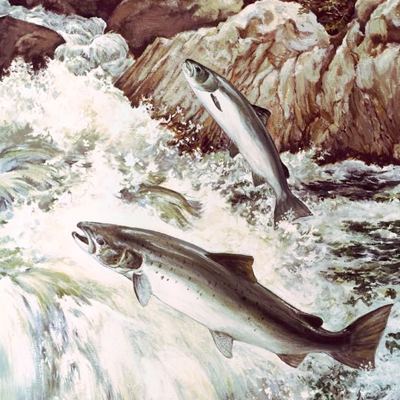HERE’S A FASCINATING yet troubling story. It involves coho salmon and their survival in West Marin.
But first, the backstory. Salmon are born in the headwaters of cold mountain streams and remain there for at least a year until they can make their way many miles downstream into an ocean. After two years amid salt waters, they return to the freshwater location of their birth, where they spawn (give birth) and die. But logging, dam construction, overfishing, and global climate change have threatened their existence worldwide.
In California, coho salmon are vital to the ecosystem. There are also economic repercussions for the $4.2 billion salmon fishing industry. In 1960, there was an estimated 6,000 coho in West Marin’s Lagunitas Creek watershed; in the early 2000s, only 60 were spotted.
For 20 years, restoring the coho salmon in West Marin has been a priority for Marin County and the Marin Municipal Water District as well as the National Park Service and the National Oceanic and Atmospheric Administration. Several million in taxpayer dollars have been spent on the effort, and last winter almost 600 coho were seen in Lagunitas Creek.
Some of that improvement must be attributed to SPAWN, the Salmon Protection and Watershed Network, a grassroots nonprofit formed in 1997 to help in the preservation effort. At its outset, SPAWN and its director, Todd Steiner, were hailed for their efforts. Volunteers restored habitats, planted shade trees, monitored creeks, and increased awareness. In 2000, SPAWN raised $100,000 to eliminate Roy’s Dam in San Geronimo Valley, allowing salmon to migrate upstream.
But of late, observers say SPAWN has become more hindrance than help in the effort to restore coho salmon to Lagunitas Creek. It has sued the county three times since 2005, basically claiming Marin does little to protect salmon from the impacts of development. The outcomes of these suits are mostly unimpressive — a lone result is the county being forced to pay SPAWN’s legal expenses of more than $650,000 for work reportedly done pro bono.
“While I respect SPAWN’s passion to restore the coho salmon, I disagree vehemently with their efforts to repeatedly sue the county in an effort to restrict homeowners from improving their properties,” Steve Kinsey, a Marin County Supervisor who represents Lagunitas Creek residents, recently said. “It has been proven repeatedly that coho endangerment comes primarily from dams, droughts and ocean warming — not from a new deck built some distance from the creek.” Kinsey would prefer that SPAWN work collaboratively with the county, MMWD and the Marin Conservation League.
John McCosker, emeritus chair of the Aquatic Biology Department at the California Academy of Sciences and a former advisor to SPAWN, is also concerned. “While being well intended, Todd Steiner, with his alarmist approach, runs the risk of having SPAWN lose credibility, and I’ve told him this on several occasions.”
Perhaps most critical of SPAWN is Russell Chatham, a renowned Point Reyes Station artist and author of four well-received books on fishing who for most of his life has angled West Marin’s many creeks. “Thanks to Steiner and his lawsuits, SPAWN has alienated Lagunitas Creek homeowners, the ones who most want to see the salmon return,” he says, pointing out that Redwood Creek, which runs through Muir Woods National Monument, has also seen its coho population diminish. “And it’s heavily protected, totally undeveloped and intensely shaded.” SPAWN “thinks they’re protecting Lagunitas Creek,” Chatham recently said. “Yet as far as I’m concerned, their actions are doing anything but that.”
For there to be any hope of turning the coho situation around, SPAWN would do best to work in concert with those who share the group’s goal of seeing the salmon return to the Lagunitas Creek watershed. That’s my point of view. What’s yours?
This article originally appeared in Marin Magazine’s print edition with the headline: “Swimming Upstream”.


